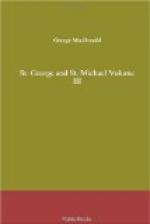Richard continued to ride Bishop, which became at length famous for courage, as he had become at once for ugliness. Fortunately they found that he had developed friendly feelings towards one of the mares of the troop, never lashing out when she happened to be behind him; so they gave her that place, and were freed from much anxiety. Still the rider on each side of him had to keep his eyes open, for every now and then a sudden fury of biting would seize him, and bring chaos in the regiment for a moment or two. When his master was made an officer, the brute’s temptations probably remained the same, but his opportunities of yielding to them became considerably fewer.
It was strange company in which Richard rode. Nearly all were of the independent party in religious polity, all holding, or imagining they held, the same or nearly the same tenets. The opinions of most of them, however, were merely the opinions of the man to whose influences they had been first and principally subjected: to say what their belief was, would be to say what they were, which is deeper judgment than a man can reach. In Roger Heywood and his son dwelt a pure love of liberty; the ardent attachment to liberty which most of the troopers professed, would have prevented few of them indeed from putting a quaker in the stocks, or perhaps whipping him, had such an obnoxious heretic as a quaker been at that time in existence. In some was the devoutest sense of personal obligation, and the strongest religious feeling; in others was nothing but talk, less injurious than some sorts of pseudo-religious talk, in that it was a jargon admitting of much freedom of utterance and reception, mysterious symbols being used in commonest interchange. That they all believed earnestly enough to fight for their convictions, will not go very far in proof of their sincerity even, for to most of them fighting came by nature, and was no doubt a great relief to the much oppressed old Adam not yet by any means dead in them.
At length the king led out his men for another campaign, and was followed by Fairfax and Cromwell into the shires of Leicester and Northampton. Then came the battle at the village of Naseby.
Prince Rupert, whose folly so often lost what his courage had gained, having defeated Ireton and his horse, followed them from the field, while Cromwell with his superior numbers turned Sir Marmaduke Langdale’s flank, and thereby turned the scale of victory.
But Sir Marmaduke and his men fought desperately, and while the contest was yet undecided, the king saw that Rupert, returned from the pursuit, was attacking the enemy’s artillery, and dispatched Rowland in hot haste to bring him to the aid of Sir Marmaduke.
The straightest line to reach him lay across a large field to the rear of Sir Marmaduke’s men. As he went from behind them, Richard caught sight of him and his object together, struck spurs into Bishop’s flanks, bored him through a bull-fence, was in the same field with Rowland, and tore at full speed to head him off from the prince.




